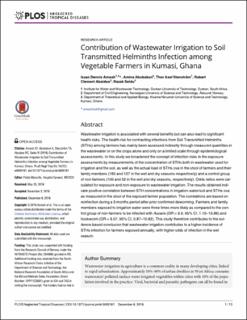| dc.contributor.author | Amoah, Isaac Dennis | |
| dc.contributor.author | Abubakari, Amina | |
| dc.contributor.author | Stenström, Thor Axel | |
| dc.contributor.author | Abaidoo, Robert Clement | |
| dc.contributor.author | Seidu, Razak | |
| dc.date.accessioned | 2020-03-25T13:22:31Z | |
| dc.date.available | 2020-03-25T13:22:31Z | |
| dc.date.created | 2017-02-03T11:04:36Z | |
| dc.date.issued | 2016 | |
| dc.identifier.citation | PLoS Neglected Tropical Diseases. 2016, 10 (12) | en_US |
| dc.identifier.issn | 1935-2727 | |
| dc.identifier.uri | https://hdl.handle.net/11250/2648611 | |
| dc.description.abstract | Wastewater irrigation is associated with several benefits but can also lead to significant health risks. The health risk for contracting infections from Soil Transmitted Helminths (STHs) among farmers has mainly been assessed indirectly through measured quantities in the wastewater or on the crops alone and only on a limited scale through epidemiological assessments. In this study we broadened the concept of infection risks in the exposure assessments by measurements of the concentration of STHs both in wastewater used for irrigation and the soil, as well as the actual load of STHs ova in the stool of farmers and their family members (165 and 127 in the wet and dry seasons respectively) and a control group of non-farmers (100 and 52 in the wet and dry seasons, respectively). Odds ratios were calculated for exposure and non-exposure to wastewater irrigation. The results obtained indicate positive correlation between STH concentrations in irrigation water/soil and STHs ova as measured in the stool of the exposed farmer population. The correlations are based on reinfection during a 3 months period after prior confirmed deworming. Farmers and family members exposed to irrigation water were three times more likely as compared to the control group of non-farmers to be infected with Ascaris (OR = 3.9, 95% CI, 1.15–13.86) and hookworm (OR = 3.07, 95% CI, 0.87–10.82). This study therefore contributes to the evidence-based conclusion that wastewater irrigation contributes to a higher incidence of STHs infection for farmers exposed annually, with higher odds of infection in the wet season | en_US |
| dc.language.iso | eng | en_US |
| dc.publisher | PLOS, Public Library of Science | en_US |
| dc.rights | Navngivelse 4.0 Internasjonal | * |
| dc.rights.uri | http://creativecommons.org/licenses/by/4.0/deed.no | * |
| dc.title | Contribution of Wastewater Irrigation to Soil Transmitted Helminths Infection among Vegetable Farmers in Kumasi, Ghana | en_US |
| dc.type | Peer reviewed | en_US |
| dc.type | Journal article | en_US |
| dc.description.version | publishedVersion | en_US |
| dc.source.volume | 10 | en_US |
| dc.source.journal | PLoS Neglected Tropical Diseases | en_US |
| dc.source.issue | 12 | en_US |
| dc.identifier.doi | 10.1371/journal.pntd.0005161 | |
| dc.identifier.cristin | 1446535 | |
| dc.description.localcode | Copyright: © 2016 Amoah et al. This is an open access article distributed under the terms of the Creative Commons Attribution License, which permits unrestricted use, distribution, and reproduction in any medium, provided the original author and source are credited. | en_US |
| cristin.ispublished | true | |
| cristin.fulltext | original | |
| cristin.qualitycode | 1 | |

